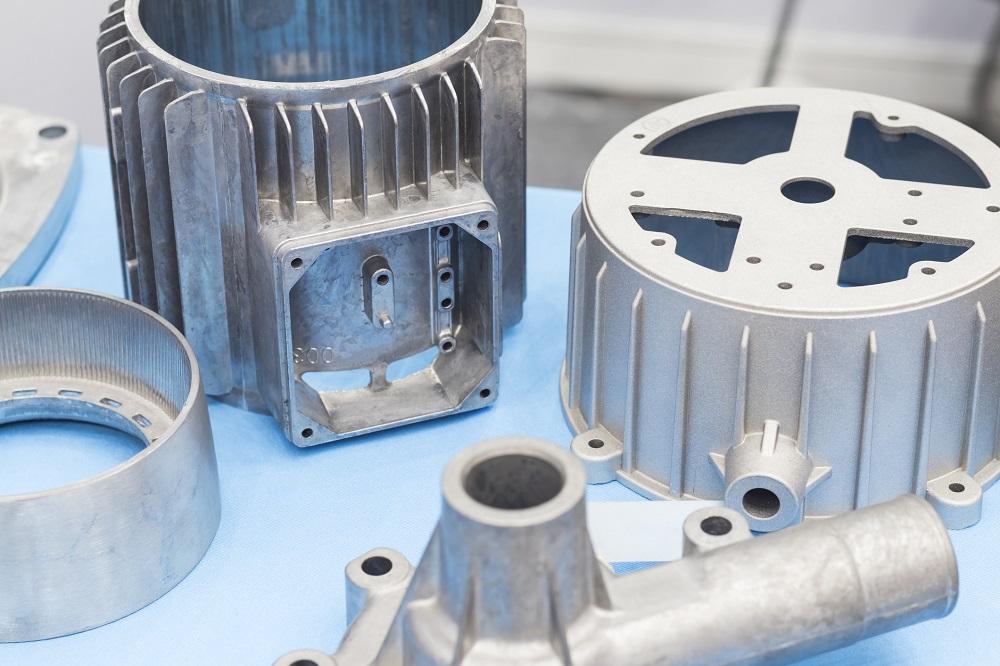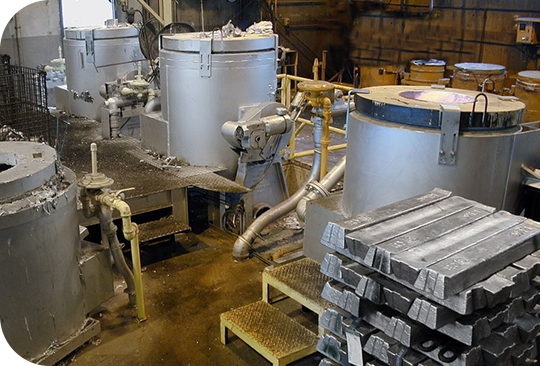Top 7 applications of Aluminum Casting in modern industry
A Comprehensive Guide to the Various Types and Applications of Aluminum Castings
Aluminum castings are essential parts in different sectors, understood for their lightweight and sturdy properties. Various casting techniques, such as sand, pass away, and financial investment casting, offer distinctive advantages customized to particular applications. Understanding these procedures is vital for picking the right method for a task. Each method has its one-of-a-kind benefits, affecting style and manufacturing options. The expedition of these methods discloses a deeper understanding into their effect on modern manufacturing.
Review of Aluminum Castings
Aluminum castings are important parts in various sectors, known for their lightweight and corrosion-resistant properties. These castings are created via processes that enable detailed designs and high dimensional precision. The convenience of aluminum makes it an optimal selection for a series of applications, from vehicle components to consumer electronics. Because of its superb thermal and electrical conductivity, aluminum is likewise preferred in electric real estates and heat sinks. Aluminum castings can be treated with numerous surface finishes, enhancing their aesthetic charm and longevity. The product's recyclability adds to its sustainability credentials, making it an environmentally friendly choice. Furthermore, the schedule of various aluminum alloys permits suppliers to customize the mechanical properties to certain needs, giving enhanced toughness or improved resistance to put on. Generally, aluminum castings play a substantial duty in modern manufacturing, contributing to the efficiency and performance of many products throughout varied markets.
Sand Casting: Refine and Applications
While numerous casting approaches exist, sand casting stays one of one of the most widely utilized techniques because of its simplicity and versatility. This process includes creating a mold from a combination of sand and a binding representative, enabling the manufacturing of intricate shapes with high dimensional precision. The aluminum is thawed and put right into the mold and mildew, where it takes the desired form as it cools and solidifies.
Sand casting is specifically efficient for generating big parts and reduced to medium quantity runs, making it ideal for different sectors, consisting of vehicle, aerospace, and durable goods. Its versatility permits the casting of intricate layouts, suiting varied specifications. Furthermore, sand mold and mildews can be reused numerous times, improving cost-effectiveness. The simplicity of sourcing materials and the relatively low configuration prices better add to its extensive adoption. In general, sand casting plays a pivotal role in the aluminum casting landscape, fostering advancement and efficiency.
Die Casting: Benefits and Makes use of
Die casting offers several advantages that make it a preferred method for generating aluminum elements in different markets. This procedure enables high-volume production with extraordinary dimensional accuracy and surface coating. The fast solidification of aluminum during die casting leads to a solid and durable product, decreasing the demand for substantial machining or ending up procedures.
In addition, die casting makes it possible for the production of intricate shapes and intricate layouts, which can be testing to attain with other casting techniques. The effective use materials reduces waste, making it an affordable solution for makers.
Applications of die casting span different markets, including auto, aerospace, and consumer electronic devices, where lightweight and high-strength elements are crucial. Generally, pass away casting stands apart for its ability to provide high quality, efficiency, and adaptability in aluminum component manufacturing, strengthening its function in modern-day manufacturing practices.
Investment Casting: Precision and Detail
Financial investment casting is a precision manufacturing procedure that permits intricate designs and detailed features in aluminum parts (Aluminum Casting). This method provides various benefits, consisting of high dimensional precision and a smooth surface area finish. Its versatility makes it appropriate across different sectors, from aerospace to clinical devices
Refine Review
The financial investment casting procedure attracts attention for its capability to create complex aluminum components with impressive accuracy and detail. This method starts with producing a wax or polymer pattern that is a replica of the desired part. Next, the pattern is covered with a ceramic covering, which is then heated to harden. Once the shell is established, the wax is thawed away, leaving a dental caries in the shell. Liquid aluminum is put right into this tooth cavity, loading it to develop the final part. After cooling, the ceramic covering is escaped, exposing the actors part. This process enables intricate geometries and fine surface coatings, making it appropriate for different applications, from aerospace to vehicle markets.
Benefits of Investment Casting
One of the main advantages of financial investment casting hinges on its capacity to provide high-precision components with elaborate details. This technique permits the production of complex geometries that are usually unattainable via other casting strategies. Investment casting reduces the need for extensive machining, lowering material waste and manufacturing time. Furthermore, it allows using various aluminum alloys, boosting the versatility of the end product. The process is defined by a smooth surface area finish, which can cause boosted functionality and looks. Investment casting is fit for both little and huge manufacturing runs, accommodating a vast variety of sectors. In general, its accuracy and performance make investment casting a favored choice for producing elements calling for precise specs.
Applications in Market
While numerous casting approaches offer particular purposes, investment casting stands apart for its prevalent applications throughout several industries due to its unparalleled accuracy and detail. This technique is particularly preferred in aerospace and auto markets, where intricate elements need specific specifications for safety and efficiency. Investment casting allows for the production of intricate shapes, such as generator blades and engine parts, that typical methods can not attain. Additionally, medical gadget producers utilize financial investment casting for producing extremely comprehensive tools and implants, making certain biocompatibility and performance. The electrical and electronic devices markets additionally profit, producing components like housings and adapters that demand great resistances. Overall, financial investment casting's flexibility and precision make it a necessary process in modern-day manufacturing throughout diverse areas.
Comparison of Casting Approaches

Sand Casting Advantages
Sand casting offers a number of benefits over various other casting methods, especially when it involves versatility and cost-effectiveness. This page method enables the manufacturing of complex shapes and big parts without the demand for expensive tooling. Additionally, the sand utilized in this procedure is conveniently offered and affordable, making it an appealing alternative for both tiny and huge production runs. The ability to reuse sand promotes sustainability and decreases product expenses. In addition, sand casting suits a variety of aluminum alloys, enhancing its adaptability for different applications. The process is also relatively easy, which adds to view it now shorter lead times and flexibility in manufacturing. These factors make sand casting a preferred choice for several sectors looking for trusted and affordable remedies.
Die Casting Performance
Although numerous casting techniques are offered, die casting stands apart for its efficiency, particularly in high-volume manufacturing circumstances. This approach utilizes high-pressure forces to infuse liquified aluminum into a mold, causing fast cycle times and consistent item high quality. Compared to sand casting and financial investment casting, pass away casting considerably reduces product waste and enables intricate layouts with tight tolerances. The ability to generate huge quantities of components swiftly makes it perfect for industries such as vehicle and durable goods. In addition, pass away casting can assist in the use of much less costly alloys, additionally improving its cost-effectiveness. In general, the efficiency of die casting makes it a favored choice for makers aiming to maximize both production rate and quality.
Financial Investment Casting Accuracy
Investment casting is extensively recognized for its phenomenal precision in generating complex shapes and detailed details. This technique entails developing a wax pattern, which is coated in a ceramic covering, and consequently dissolved, leaving an exact tooth cavity for molten aluminum. Contrasted to other casting techniques, such as sand casting or pass away casting, investment casting provides tighter tolerances and a smoother surface finish. This precision makes it suitable for applications needing high accuracy, such as aerospace and medical device elements. While the first arrangement costs may be greater, the long-term advantages include minimized machining requirements and regular quality. Subsequently, financial investment casting stands out as a preferred choice for elaborate styles and demanding requirements in numerous sectors.
Sector Applications of Aluminum Castings
Aluminum castings play a crucial function throughout numerous industries due to their lightweight, corrosion-resistant homes and superb strength-to-weight ratio. In the automotive sector, aluminum castings are thoroughly used for engine elements, transmission real estates, and structural parts, official website adding to sustain effectiveness and efficiency. The aerospace industry take advantage of aluminum castings in airplane frames, engine installs, and interior fittings, where weight decrease is important.
In enhancement, the consumer electronic devices field utilizes aluminum castings for enclosures and components, enhancing durability while keeping a smooth visual. In the building market, aluminum castings are utilized in building components, window structures, and architectural assistances, offering strength against weathering. In addition, the marine industry favors aluminum castings for watercraft hulls and installations as a result of their resistance to saltwater deterioration. Overall, aluminum castings use versatile options, fulfilling varied requirements throughout different applications while keeping high efficiency and reliability.

Future Patterns in Aluminum Casting Modern Technology
As markets remain to progress, innovations in aluminum casting innovation are poised to reshape making procedures and item design. Emerging patterns include the assimilation of automation and expert system, streamlining manufacturing and boosting quality assurance. 3D printing is likewise getting grip, enabling a lot more intricate geometries and reduced waste, therefore advertising sustainability. Furthermore, the advancement of high-performance alloys is broadening the applications of aluminum castings, enabling markets to fulfill rigorous performance criteria.
Another significant fad is the increasing emphasis on recycling and the round economic climate, with innovations targeted at recycling aluminum scrap efficiently. Sector players are additionally purchasing smart manufacturing methods, including IoT for real-time surveillance and anticipating maintenance. Lastly, advancements in surface area therapy innovations are improving the toughness and visual appeal of aluminum castings. Jointly, these trends represent a transformative duration in aluminum casting, driving efficiency, sustainability, and innovation across numerous sectors.
Regularly Asked Concerns
What Are the Environmental Influences of Aluminum Casting Processes?
The ecological influences of aluminum casting processes consist of greenhouse gas discharges, energy intake, and waste generation. These elements add to air and water air pollution, prompting the requirement for sustainable methods and enhanced source administration in the sector.
How Can Aluminum Castings Be Recycled Effectively?
Effective recycling of aluminum castings includes accumulating scrap, removing pollutants, and melting the aluminum to produce new castings. This procedure saves power, reduces waste, and minimizes ecological influences, promoting a much more lasting manufacturing cycle.
What Is the Regular Life Expectancy of Aluminum Castings?
The normal life-span of aluminum castings differs considerably, commonly long lasting in between 20 to 50 years relying on environmental elements, alloy structure, and application. Their resilience makes them suitable for numerous requiring industrial and structural uses.
Exist Any Type Of Health And Wellness Threats Connected With Aluminum Casting?
Problems pertaining to wellness dangers related to aluminum casting include potential direct exposure to fumes and dirt. Extended inhalation might cause breathing issues, while skin call can trigger inflammation. Appropriate precaution are vital to alleviate these dangers.
How Do Aluminum Castings Compare to Various Other Materials in Toughness?
Aluminum castings exhibit a beneficial strength-to-weight proportion contrasted to lots of products, consisting of steel and plastics (Aluminum Casting). They are lightweight yet strong, making them excellent for applications calling for toughness without too much weight, such as automobile and aerospace parts